Do you want to learn about chord inversions?
Chord inversions are an important part of music theory. They allow you to create new voicings of the chords by changing the order of the notes in a basic chord. This can add interest and variety to your music.
Learning about chord inversions can help you play guitar or piano more effectively. You will be able to create new chord voicings with proper voice leading and understand how they work. This will make your playing sound more professional and interesting.
Read the complete article below and start learning about chord inversions!
What are Chord Voicings & Chord Inversions?
Let us begin with chord voicings to drive in the concept of chord inversion.
Chord Voicings
Music theory defines chord voicings as a combination of two related concepts.
- The distribution of notes and chords to the different instruments.
- The vertical placement of notes.
How a composer or a musician ranges the notes in a chord defines the chord voicing. Which, in simplest terms, is the arrangement of chord notes. The arrangement, as pointed out earlier, can be based on the different instruments or the vertical spacing and order of the notes of the chord.
We will deal with just the second concept in this article, leaving the instruments part to another article.
The Vertical Placement
The vertical placement deals with the octave or the frequency of the note and the order in which they are arranged. This leads us to the following fundamental arrangements:
- Close Position: It is the most compact position of notes, within one octave.
- Open Harmony: This arrangement has wider spacing. Notes are in open harmony if the lowest and highest pitch notes are more than one octave apart.
- Doubling: If any note is played in more than one octave, it is said to be doubled.
For example, the closed position of the C Major chord is with notes {C E G}. This chord is said to be in the root position with notes arranged from the lower to higher in order of the notes in the C major scale. When we play the chord as {C G E}, it is still the C chord but in a different voicing as the order and highest note has changed from G to E.
In addition, any chord has multiple shapes on a guitar, and each one is called a voicing. In the open position (shown in the chord diagram for the C major triad below), C and E appear twice, while G appears only once.
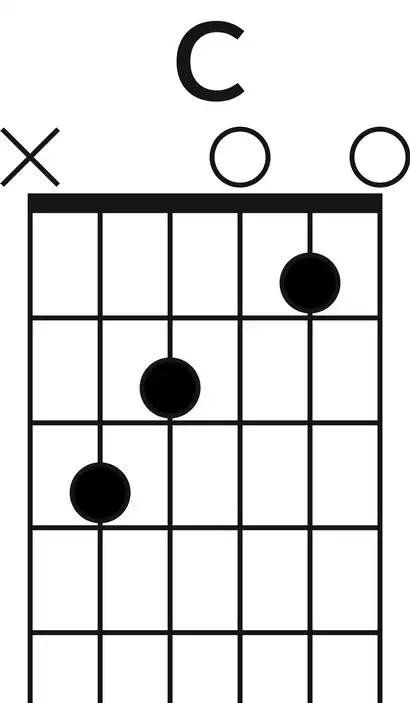
Chord Inversions – How do chord inversions relate to basic chords?
In the above voicings, the root was the lowest note. The special cases of voicings, where the root is not the lowest note, are known as inversions.
As you know, a large proportion of the chords that we encounter in music are based on tertian harmony, i.e., they are made of intervals of thirds stacked over the root. If you rearrange the notes of such triads so that the original root note does not remain the bass note, you have created an Inversion.
An inversion basically describes the relationship between the root and the other notes in the chord.
Types of Basic Chord Inversions
The inverted triads are the most basic forms of inverted chords. Let us start our study by understanding them in detail before moving on to other chord types.
Major Triad Inversions
Since a major triad has three notes, they have three positions, the original chord and its two inversions.
For example, in its original form, C Major has {C E G} as its notes with C in the root of the chord. This form is known as the parent chord or the root position chord. Some even call it a root inversion. Its different inversions are
The first inversion of any major chord has the major 3rd as its bass note. For example, the 1st inversion of the C major has {E, G, C} as its notes. The new intervals of the inverted chord are Bass Note (E) – minor 3rd (G) – minor 6th (C). Basically, in the inversion, the C note has shifted one octave above its original position. This is why it is also referred to as the “6” chord.
The second inversion has the perfect 5th interval of the original chord as its bass note. So both the notes – the root and the 3rd – have shifted an octave up. The new order of notes for the second inversion triad is {G, C, E}. The new intervals are G to C – a perfect 4th and C to E – a Major 6th. This is also known as a 6/4 chord because of the 6th and 4th intervals. This is also referred to as a 6Sus4 chord (R, P4, M6}.
Minor Triad Inversions
The inversions of a minor triad follow similar rules as above. Consider the example of A minor chord {A, C, E} for the discussion.
The 1st inversion of A minor is usually played as {C E A} with the intervals of a Major 3rd and a Major 6th from the new bass. The new chord is actually a CMajor6 chord without the 5th interval. These inversions are also known as “6” chords, like the major triads.
As stated earlier, the 2nd Inversion is formed by moving the two lowest notes an octave higher. So for A minor chord, {E, A, C} is the 2nd inversion with E as the bottom note. It contains P4 and m6 intervals and is also designated as a “6/4” chord.
Diminished and Augmented Chord Inversions
As you are aware, diminished chords contain only stacked minor 3rd intervals, while augmented chords are built with only Major 3rd intervals. They fall into a category known as symmetrical chords. Due to the symmetry, the inversions of the full diminished 7th chords and augmented triads yield the same type of chords, with just the bass note of the given chord shifting up by a minor or a major 3rd with each inversion.
Let us consider the B diminished triad in the key of C major with the notes {B D F}. The first inversion has the notes {D F B}. It has a minor 3rd and a major 6th interval from the new bottom note, like a “6” chord.
The second inversion {F B D} has an augmented 4th and a major 6th interval, again forming a “6/4” chord.
How to notate triad chord inversions
Using a Slash Chord Symbol
One of the common methods used to notate the inverted chords is to represent them by the slash chords. As you can figure out, they derive their name from the forward slash symbol used between the two letter names to represent them. For example, Cm/Eb and Cm/G represent the two inversions of the C minor triad.
The first part, on the left of the forward slash, represents the parent chords, while the right part represents the bass note of the inversion. G, as the bass note, implies the second inversion of the Cm chord.
The slash cords are sometimes used to notate chords with chromatic notes as their bass. So C/B represents a C major chord played over the B bass note. But this method with chromatic notes is not a good practice and should be avoided. We just mentioned it to make you aware.
Roman Numerals and Arabic Numbers
The inversions may be represented by Roman numerals and Arabic numbers using the figured bass system. You had briefly seen the system earlier but without clear details and references. Let us detail it now.
Inversions using the Arabic Numbers
In the Figured bass notations, the inversions are represented by the Arabic numbers above or below the bass note in the form of a chord progression. The numbers represent the intervals above the bass note.
- In the parent chord, the intervals above the root note are a third and a fifth, so the parent chord is represented as 5/3 chords. However, the root position triads do not carry any symbol, and 5/3 is implied.
- As discussed earlier, the 1st inversions have third and 6th intervals. So they are known as 6/3 chords. However, they are customarily abbreviated as just the “6” chords.
- Similarly, the 2nd inversions are the “6/4” chords due to 4th and 6th intervals over the bass note.
The figured bass chord symbols only relate to the intervals over the bass note. They provide no other information related to the chord, like the key of progression, intervals between upper notes, or if any upper note is doubled, etc.
Chord Inversions In Roman Numerals
You know that in the Roman numeral system, the chords are represented by the scale degrees, also known as their harmonic degrees. So a tonic chord with the scale degree 1 is represented as “I,” a dominant chord as “V.”
Their inversions make use of the combination of both the system and tonic chord inversions are represented as “I6” and “I6/4” for the 1st and 2nd inversions, respectively. Similarly, the inversions of the dominant chords are represented as “V6” and “V6/4“
Lowercase Letters
In this method, the lowercase alphabet is used to denote the inversions. For example, Ia, Ib, and Ic represent the root, 1st, and 2nd inversions of the tonic or the I chord, respectively. Similarly, iiib and iiic represent the 1st and 2nd inversions of the minor chords with scale degrees 3 as their root in a major key.
7th and Extended Chord Inversions
The inversions of the seventh chords and the extended chords result in complex chords. Any seventh cord has a four-note structure and, consequently, three inversions. Let us consider a major 7th chord with {1 3 5 7} structure. Hence a CMaj7 chord has {C E G B} as its notes.
Its first chord inversion has notes {3 5 7 1} with 3 as the bass note and 1 as the top note. For example, {E G B C} is the 1st inversion of CM7.
The four notes of the second inversion are {5 7 1 3} or {G B C E} for CM7.
The notes of the third inversion are {7 1 3 5} or {B C E G} for CM7.
These chords find a variety of uses in Jazz and classical music, with the most common being that of a substitution chord. By the same method, you can find the inversion of any extended chord. The 9th chords have four inversions, the 11th chords have five, and so on.
How Do Chord Inversions work on the Piano?
Chord inversions are much easier to play on a piano in comparison to the guitar. All you need to do is to shift the lowest note of the original chord up by one octave. If you were using the keys G3, B4, and D4 to play the G triad, you could play inversion by
- 1st inversion – Use B4, D4 and G4 keys. You have moved the original root up by one octave.
- 2nd Inversion – Use the D4, G4 and B5 keys to shift B up by one octave from the 1st inversion.
Common Guitar Chord Inversion Patterns
You can now look at how to play the chord inversions on the guitar fretboard in this section. We will go through the patterns related to the two inversions of the major and minor triads on each of the lowest three strings (4th to 6th).
4th String – Major and Minor Chord Inversions
The first row of diagrams shows the F major chord in the root, 1st, and 2nd inversion positions on the guitar fretboard. The root of the original chord is in the 4th string. The second row shows similar diagrams for the F minor chord.
Major Chord Inversions
Root Position
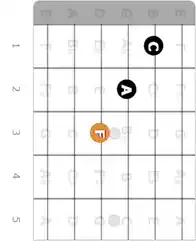
1st Inversion
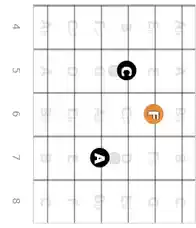
2nd Inversion
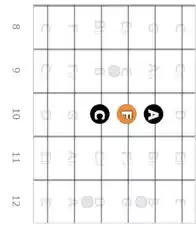
Minor Chord Inversions
Root Position
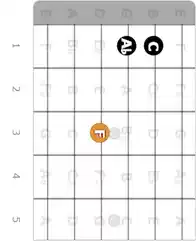
1st Inversion
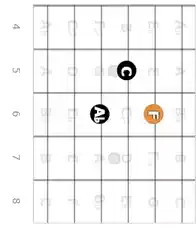
2nd Inversion
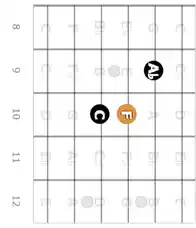
5th String – Major and Minor Chord Inversions
You can now see the diagrams of D major and D minor chords in a similar way as above, with their root on the fifth string.
Major Chord Inversions
Pattern 1
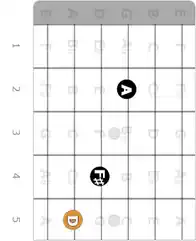
Pattern 2
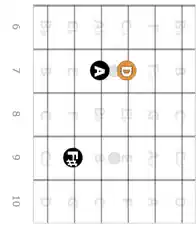
Pattern 3
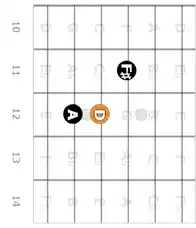
Minor Chord Inversions
Pattern 1
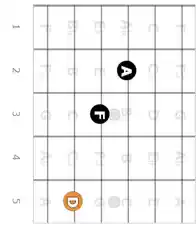
Pattern 2
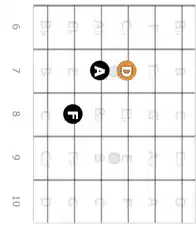
Pattern 3
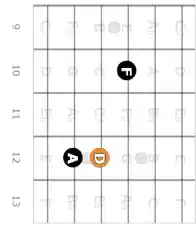
6th String – Major and Minor Chord Inversions
Finally, you can see similar diagrams of A major and A minor chords with their root on the sixth string.
Major Chord Inversions
Pattern 1
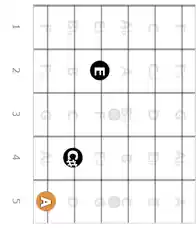
Pattern 2
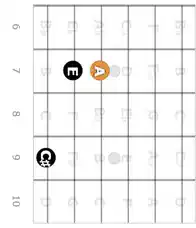
Pattern 3
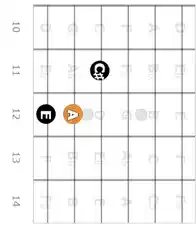
Minor Chord Inversions
Pattern 1
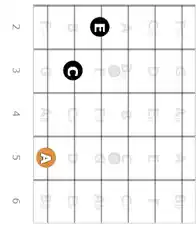
Pattern 2
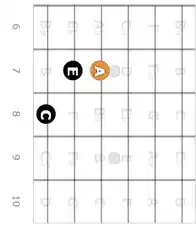
Pattern 3
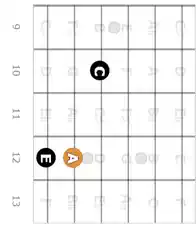
Uses for chord inversions in music
As you may be aware that the different inversions of any chord are functionally equivalent. The change in the bass note has some effect, as the bass note has more harmonic weight due to more powerful fundamentals and overtones compared to the other notes at higher pitches.
Inversions are primarily used to smoothen out the transitions in the chord progressions in a process known as voice leading. Many times the chords in a progression have to leap by intervals spanning a Perfect fourth or more, which makes them sound a bit clunky. By voice leading, it is ensured that no note in chord transitions by more than one step during a chord progression.
Root Position Chord Changes
As stated above, a change in the root position chords of a major scale can cause bigger leaps. For example, the I – IV chord change in the key of C major involves a change from C Major {C E G} to F Major {F A C}.
If instead of the IV chord in the root position, we use its second inversion {C F A}, there is no change in the bass note, E changes to F, and G changes to A with a maximum transition of two semitones.

1st Inversion Chord Changes
Instead of a root position to the second inversion chord change above, we can also use the first inversion I chord {E G C} to transition to the IV chord {F A C}. The bass note changes by one semitone, the second note by two semitones, and the top note are same in both chords.

The 7th Chord Progressions
Consider an ii – V – I chord progression in the key of C, which means, Dm7 – G7 – CM7. The notes in these chords are Dm7 – {D F A C}, G7 – {G B D F}, and CM7 – {C E G B}.
To minimize the transition intervals, if we invert the G7 chord to its 2nd inversion, we get Dm7 – {D F A C} to V(c) of G7 – {D F G B}. This involves a transition by {0, 0, 2, 1} semitones in the four notes.
Similarly, from the 2nd inversion of G7 to the root position of CM7, we get V(c) of G7 – {D F G B} to CM7 {C E G B}. The last two notes are the exact match, and the first two notes have 2 and 1 semitone shift.
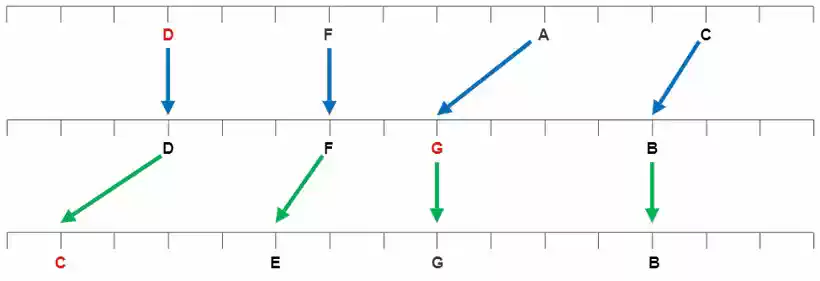
Conclusion
We hope you enjoyed learning about guitar chords and their different shapes! If you have any questions or want clarification on anything, please leave us a comment below, and we’ll be happy to help you out.

